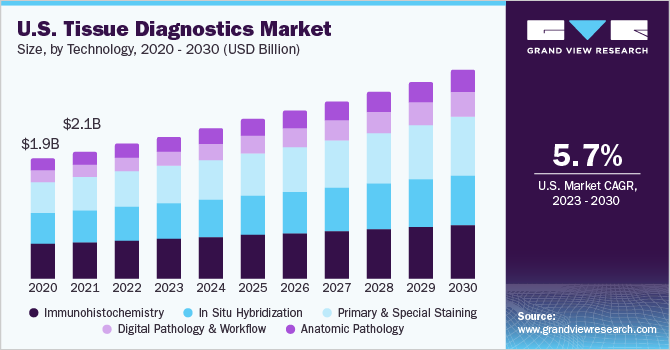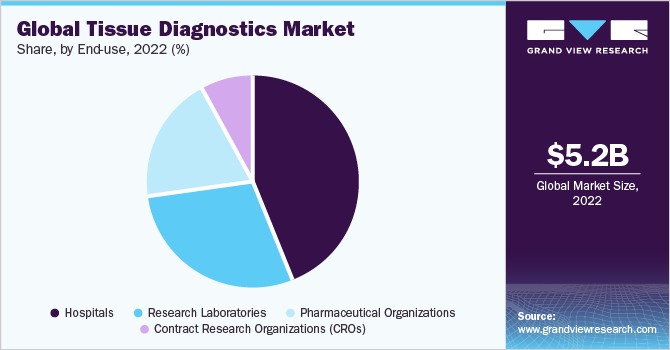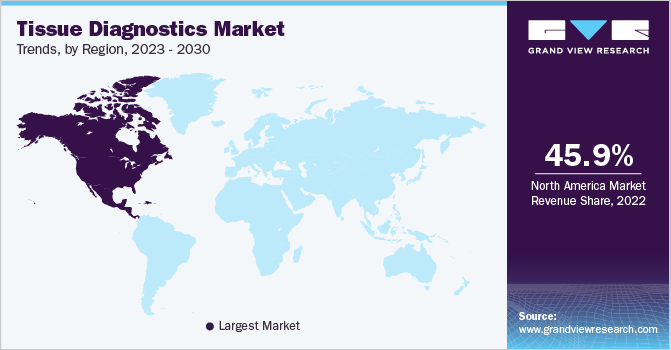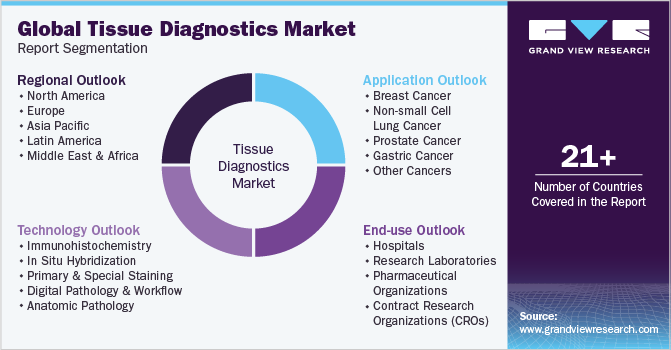- Home
- »
- Clinical Diagnostics
- »
-
Tissue Diagnostics Market Size And Growth Report, 2030GVR Report cover
![Tissue Diagnostics Market Size, Share & Trends Report]()
Tissue Diagnostics Market Size, Share & Trends Analysis Report By Technology (ISH, Digital Pathology), By Application (Breast Cancer, Prostate Cancer), By End-use, By Region, And Segment Forecasts, 2023 - 2030
- Report ID: 978-1-68038-399-7
- Number of Pages: 180
- Format: Electronic (PDF)
- Historical Range: 2018 - 2021
- Industry: Healthcare
Report Overview
The global tissue diagnostics market size was estimated at USD 5.19 billion in 2022 and is expected to grow at a compound annual growth rate (CAGR) of 7.15% from 2023 to 2030. Tissue diagnostics remains a gold standard for cancer diagnosis as these technologies capture the anatomy of tumors. With rising incidences of cancer, the tissue diagnostics industry witnesses high demand with significant growth opportunities over the forecast period. The impact of COVID-19 on the tissue diagnostics industry has been significant. During the pandemic, there was a slowdown in routine medical procedures, including diagnostic testing, as healthcare resources were redirected toward managing the virus.

The pandemic led to a temporary decline in the demand for tissue diagnostics products and services. However, as the situation improved and healthcare systems adapted to the new normal, the market began to recover. The need for accurate diagnosis and monitoring of various diseases, including cancer, remained high, driving the demand for tissue diagnostics in the post-pandemic period.
Cancer incidences are increasing dramatically, which has caused a paradigm change in anatomic pathology. This, in turn, is contributing to the clinical pathology field's continued growth. Digitalization of diagnosis methods, increased use of liquid biopsy for cancer detection, and a continuous convergence of anatomical and molecular pathology. The importance of integrated bioinformatics and analyses increases as computational pathology gains momentum. Over the past two decades, the tissue diagnostics industry has changed as more advanced equipment has become available, making life easier for pathologists and physicians.
For instance, in May 2021, to increase the availability of precision medication for lung cancer, QIAGEN released its first FDA-approved tissue companion diagnostic to detect the KRAS G12C mutation in NSCLC tumors. The Rotor-Gene Q MDx instrument, a part of the modular QIAsymphony family of automation solutions, is used with the real-time qualitative PCR kit. This tool builds on QIAGEN's nine years of experience in researching and marketing KRAS CDx tests.
Globally, more than 14 million individuals are diagnosed with cancer each year, and by 2030, that figure is projected to increase to more than 21 million. Major market participants are introducing new cancer diagnosis products. For instance, Roche introduced its innovative BenchMark ULTRA PLUS system for cancer diagnostics in June 2022, enabling prompt, precise patient care. Pathologists can deliver high-quality, time-sensitive results to doctors and patients due to the BenchMark ULTRA PLUS tissue staining system's improved workflow, testing efficiency, and environmentally sustainable features.
Considering the rising worldwide cancer burden, various technologies, and improvements in tissue diagnostics (TDx) will increase pathology efficiency, which is essential for better cancer therapy and diagnosis. For example, Ibex Medical Analytics, the industry pioneer in AI-powered cancer diagnoses, and Alverno Laboratories announced a new deal in March 2023. It aims to expand the implementation of Ibex's Galen suite of Artificial Intelligence solutions to the entire Alverno network across Indiana and Illinois. The deployment comprises AI-powered solutions for cancer diagnosis across numerous tissue types and will help Alverno pathologists in providing the highest quality care for their patients.
A rise in the adoption rate of automated tissue-based diagnostic systems by research institutes enables them to diagnose tumors faster. In January 2023, MilliporeSigma announced its plans to expand its portfolio of antibodies for tissue diagnostics to help improve the classification of gliomas and other tumors in the nervous systems. Such R&D investments will ensure the market continues to grow.
Technology Insights
Based on technology, the market is divided into immunohistochemistry, in-situ hybridization, primary & special staining, digital pathology & workflow, and anatomic pathology. Immunohistochemistry (IHC) is widely applied in clinical research and development of cancer diagnostics and therapeutics, resulting in the largest revenue share of 28.76% in 2022. IHC is largely preferred over conventional enzyme staining techniques as it specifically provides variations between different types of tumors. Whereas the conventional methods detect only a restricted number of tumor tissue structures, enzymes, and proteins.
Digital pathology & workflow is estimated to witness the fastest CAGR during the forecast period. An increase in the adoption rate of whole-slide imaging (WSI) among pathologists is one of the key factors driving the segment growth. WSI extracts specific features of tumors and quantifies each component of these features to further support cancer diagnosis and provide informative clinical measures for tumors. Key players in the market are adopting strategic activities to broaden their product portfolio. For instance, in September 2021, Roche launched Digital Pathology Open Environment which facilitates software developers to integrate their image analysis tools with uPath enterprise software for tumor tissue, also developed by Roche.
Application Insights
The breast cancer segment led the tissue diagnostics market in 2022 with a revenue share of 50.15%. Breast cancer is a significant healthcare concern worldwide, and tissue diagnostics play a crucial role in its detection, diagnosis, and treatment planning. Advanced techniques, such as immunohistochemistry and in situ hybridization, are being increasingly used to analyze breast tissue samples, enabling precise characterization of tumors. This trend has fueled the demand for tissue diagnostics products and services specifically tailored for breast cancer diagnosis and management. Moreover, several research initiatives coupled with the support of the government and private centers further drive the development of effective products for breast cancer diagnosis, thus surging the market growth for this application.
The prostate cancer segment is expected to grow at the fastest CAGR during the forecast period. Remarkable progress in prostate cancer biomarker discovery due to advancements in genomic technologies has driven segment growth at a lucrative pace. The biomarker discovery has assisted the development of tissue diagnostic assays, thus providing opportunities for segment growth. Several diagnostic solutions for prostate cancer diagnosis are also available, such as immunohistochemistry (IHC) assays provided by Roche and NeoGenomics Laboratories.
Additionally, the launch of novel products further offers lucrative opportunities during the study period. For instance, in March 2023, for diagnosing prostate cancer, Qritive introduced the QAi Prostate AI (Artificial Intelligence) module. QAi Prostate analyses full slide images of prostate core needle biopsies using cutting-edge machine learning algorithms. It locates the prostatic cancer region and divides the image into benign and malignant regions. 90% of all occurrences of prostate cancer are prostate adenocarcinomas, which is the most prevalent type. QAi Prostate is a potent method for adenocarcinoma screening that employs both full slide images and regions of interest.
End-use Insights
Based on end-use, the market is divided into hospitals, research laboratories, pharmaceutical organizations, and CROs. Hospitals dominated the tissue diagnostics industry in 2022 with a revenue share of 43.67%. This was due to hospitals' high consumption and utility rates of tissue diagnostic solutions. Physicians are increasingly switching to tissue-based diagnostic testing techniques from conventional testing procedures. This is because tissue diagnostic tests reduce timelines when compared to conventional methods.
Hospitals are also undertaking agreement models for better disease diagnostics, thus propelling segment growth. For instance, in December 2022, a new study by the Mahmood Lab at Brigham and Women's Hospital was undertaken to develop a method that leverages artificial intelligence to improve the quality of images to increase the accuracy of rapid frozen tissue diagnostics.

The Contract Research Organizations (CROs) segment is anticipated to witness lucrative growth during the forecast period. CROs provide research support, and clinical trial services, and manage trials, and functions of companies and healthcare providers, which face budget constraints. A rise in the number of clinical trials and extensive research studies in the field of cancer therapy has significantly driven the demand for services provided by CROs. This has accelerated revenue generation for this segment.
Regional Insights
North America dominated the tissue diagnostics market with a share of 45.87% in 2022 owing to the high incidence rate of cancer. The presence of several public programs aims to minimize cancer incidences and raise the demand for cancer diagnosis in the regional market. The Cancer Prevention and Control Research Network is a flagship program by the Centers for Disease Control and Prevention that focuses on cancer prevention in this region.

Personalized medicine greatly relies on the use of human tissue for the development of innovative tests. An increase in the adoption of sequencing technologies and healthcare IT systems in the clinical workflow has significantly expanded personalized medicine, which further drives the usage of tissue diagnostics. The Precision Medicine Initiative in the U.S. further expands the personalized medicine industry’s growth in North America.
Asia Pacific region is estimated to witness a lucrative growth rate during the forecast period due to increased access to several tissue diagnostic assays provided by international companies. For instance, in October 2022, Hamamatsu Photonics K.K and Indica Labs announced a collaboration to offer improved integrated digital pathology workflows.
Key Companies & Market Share Insights
The tissue diagnostics market is fragmented due to the presence of several medium-to-small and large participants in the marketspace. The advent of novel diagnostic models by key players to enhance their technology portfolio has raised competitiveness in the market. For instance, in June 2022, Roche announced the launch of VENTANA DP 600 - the next-generation slide scanner. This high-capacity slide scanner provides the pathology lab with workflow flexibility and ease of use while producing stained histology slides with exceptional image quality from tissue samples. Some prominent players in the global tissue diagnostics market include:
-
F. Hoffmann-La Roche Ltd.
-
Abbott Laboratories
-
Thermo Fisher Scientific Inc.
-
Siemens
-
Danaher
-
bioMérieux SA
-
QIAGEN
-
BD
-
Merck KGaA
-
GE Healthcare
-
BioGenex
-
Cell Signaling Technology, Inc.
-
Bio SB
-
DiaGenic ASA
-
Agilent Technologies
Tissue Diagnostic Market Report Scope
Report Attribute
Details
Market size value in 2023
USD 5.55 billion
Revenue forecast in 2030
USD 8.99 billion
Growth rate
CAGR of 7.15% from 2023 to 2030
Base year for estimation
2023
Historical data
2018 - 2021
Forecast period
2023 - 2030
Report updated
Aug - 2023
Quantitative units
Revenue in USD million/billion, CAGR from 2023 to 2030
Report Coverage
Revenue forecast, company ranking, competitive landscape, growth factors, trends
Segments Covered
Technology, application, end-use, region
Regional scope
North America; Europe; Asia Pacific; Latin America; MEA
Country scope
U.S.; Canada; Germany; UK; France; Italy; Spain; Denmark; Sweden; Norway; Japan; China; India; South Korea; Australia; Thailand; Singapore; Brazil; Mexico; Argentina; South Africa; Saudi Arabia; UAE; Kuwait
Key companies profiled
F. Hoffmann-La Roche Ltd.; Abbott Laboratories; Thermo Fisher Scientific Inc.; Siemens, Danaher; bioMérieux SA; QIAGEN; BD; Merck KGaA; GE Healthcare; BioGenex; Cell Signaling Technology, Inc.; Bio SB; DiaGenic ASA; Agilent Technologies
Customization scope
Free report customization (equivalent up to 8 analysts’ working days) with purchase. Addition or alteration to country, regional & segment scope.
Global Tissue Diagnostic Market Report Segmentation
This report forecasts revenue growth and provides an analysis of the industry trends in each of the sub-segments from 2018 to 2030. For this study, Grand View Research has segmented the global tissue diagnostics market report based on technology, application, end-use, and region:

-
Technology Outlook (Revenue, USD Million, 2018 - 2030)
-
Immunohistochemistry
-
Instruments
-
Slide Staining Systems
-
Tissue Microarrays
-
Tissue Processing Systems
-
Slide Scanners
-
Other Products
-
-
Consumables
-
Antibodies
-
Reagents
-
Kits
-
-
-
In Situ Hybridization
-
Instruments
-
Consumables
-
Software
-
-
Primary & Special Staining
-
Digital Pathology and Workflow
-
Whole Slide Imaging
-
Image Analysis Informatics
-
Information Management System Storage & Communication
-
-
Anatomic Pathology
-
Instruments
-
Microtomes & Cryostat Microtomes
-
Tissue Processors
-
Automatic Strainers
-
Other Products
-
-
Consumables
-
Reagents & Antibodies
-
Probes & Kits
-
Others
-
-
-
-
Application Outlook (Revenue, USD Million, 2018 - 2030)
-
Breast Cancer
-
Non-small Cell Lung Cancer
-
Prostate Cancer
-
Gastric Cancer
-
Other Cancers
-
-
End-use Outlook (Revenue, USD Million, 2018 - 2030)
-
Hospitals
-
Research Laboratories
-
Pharmaceutical Organizations
-
Contract Research Organizations (CROs)
-
-
Regional Outlook (Revenue, USD Million, 2018 - 2030)
-
North America
-
U.S.
-
Canada
-
-
Europe
-
UK
-
Germany
-
Spain
-
France
-
Italy
-
Denmark
-
Sweden
-
Norway
-
-
Asia Pacific
-
Japan
-
China
-
India
-
South Korea
-
Singapore
-
Australia
-
Thailand
-
-
Latin America
-
Brazil
-
Mexico
-
Argentina
-
-
Middle East and Africa (MEA)
-
South Africa
-
Saudi Arabia
-
UAE
-
Kuwait
-
-
Frequently Asked Questions About This Report
b. The global tissue diagnostics market is expected to grow at a compound annual growth rate of 7.15% from 2023 to 2030 to reach USD 8.99 billion by 2030.
b. North America dominated the tissue diagnostics market with a share of 45.87% in 2022. This is attributable to the high incidence rate of cancer and the presence of several public programs that aim to minimize cancer incidence and raise the demand for cancer diagnosis supplements.
b. Some key players operating in the tissue diagnostics market include F. Hoffmann-La Roche Ltd.; Abbott Laboratories; Thermo Fisher Scientific Inc.; Siemens; Danaher;bioMérieux SA; QIAGEN; Becton, Dickinson and Company; Merck KGaA; GE Healthcare; BioGenex; Cell Signaling Technology, Inc.; Bio SB; DiaGenic ASA; and Agilent Technologies.
b. Key factors that are driving the market growth include a worldwide increase in cancer prevalence, advancements in imaging techniques and increasing affordability of diagnostics, and growth of personalized therapeutics & diagnostics.
b. The global tissue diagnostics market size was estimated at USD 5.19 billion in 2022 and is expected to reach USD 5.55 billion in 2023.
Share this report with your colleague or friend.
![gvr icn]()
NEED A CUSTOM REPORT?
We can customize every report - free of charge - including purchasing stand-alone sections or country-level reports, as well as offer affordable discounts for start-ups & universities. Contact us now
![Certified Icon]()
We are GDPR and CCPA compliant! Your transaction & personal information is safe and secure. For more details, please read our privacy policy.
We are committed towards customer satisfaction, and quality service.
"The quality of research they have done for us has been excellent."





